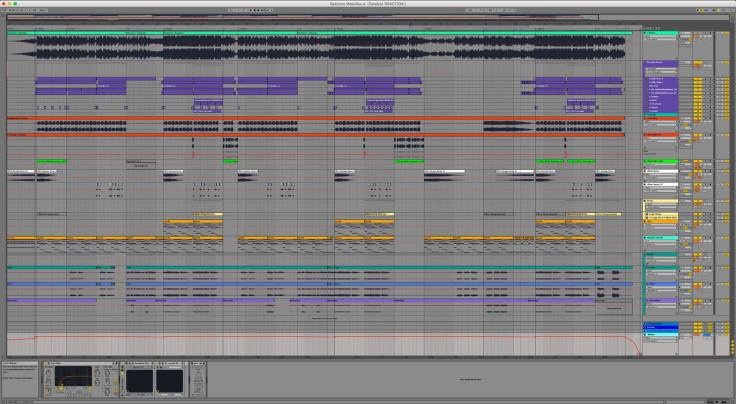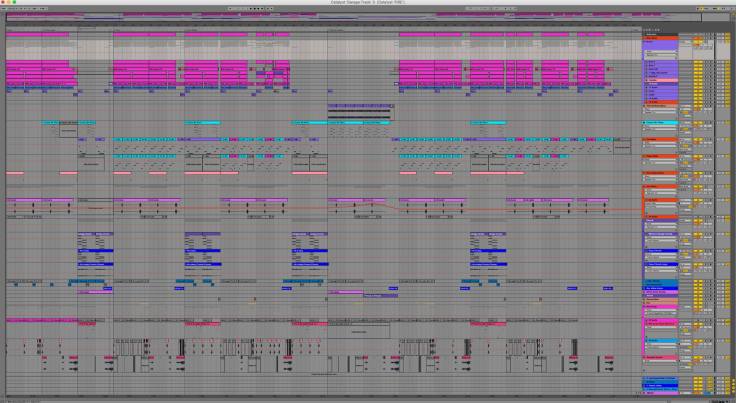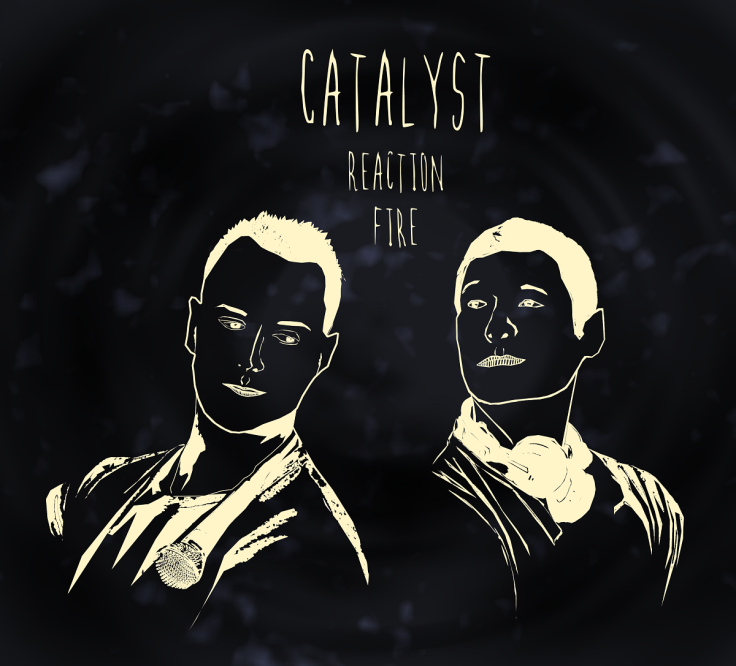This is a final reflective blog for 16T1 which is Trimester 3 of the Bachelor of Audio course I’m currently studying at SAE Institute. In this blog I will be reflecting on my projects throughout the trimester with a special focus on my major AUD210 project. I went into quite some detail with regards to my major project progress in the ‘My Project’ blog recently so here I will be re-discussing some of those details but also touching on a couple of my other projects.
Firstly I’d like to discuss my vertical integration projects for my studio 1 unit this trimester where students from trimesters 3, 4 and 5 collaborated to write a re-interpretation of a song by an Australian artist into a different genre or style. Our group chose ‘Don’t Dream It’s Over’ by Crowded House, a classic hit. We decided on writing it in a reggae style. After a fair bit of reggae drumming research, I put together a MIDI drum track in Protools which turned out to be quite the authentic sounding drum kit in the final mix. To this I attached the chord stabs with MIDI on the off-beat. A few jam sessions later and putting it into a key that fit into my vocal range, the team recorded vocals. Had a lot of fun singing along to this new found reggae beat. Charles recorded acoustic guitar and Chris recorded bass. Chloe did backing vocals. We all had a go at the final mix down and compared and turned out Chris’s mix sat the best in terms of all the audio stems gluing together. I like how he managed to get the vocal to sit within the mix. Here is a Soundcloud link to my final mix down of this project.
The second vertical integration project for the last half of the trimester was with the same group ‘Bench’ and this time we had to create a piece of music with the theme ‘Northbridge’. After generating a few ideas back and forth Chris put forward a chord progression with an 80’s hybrid sounding drum beat and bass line and trance-like melody. It sounded cool however I wanted to try using the same chord progression but really chill it out in terms of drum pattern and see what the group thought about it. So I wrote a drum loop in Ableton this time and also came up with an acoustic guitar melody loop that I thought sounded cool. The group were happy with this idea and we got Charles to improvise and also play the acoustic melody on his guitar which sounded awesome. I got my flute into the studio and did some improvisation also. The key of the song being Ab minor with 7 flats, wasn’t the easiest key to play in on a C instrument but I managed to get a few nice scale runs in the recording time that in the editing stage I could cut out the wrong notes and keep the best parts, including increasing clip gain on the really low notes of the flute which can often be very quiet dynamically in comparison to the higher registers. Although a very simple piece in the end, it’s extremely relaxing and chilled out, but at the same time a little edgy with the minor scale, flute and drum beat which I think must be my style when it comes to creating music, so I’ve discovered. Here’s a Soundcloud link to the final mix down I did for this project.
I’d now like to move onto my major project for 16T1 AUD210 which is my collaboration major project with fellow student Matthew Osborne. Well what can I say, I’m actually overwhelmingly happy and still very excited about the result of working with him and on this awesome project. We created a 2 Track EP from scratch titled ‘Catalyst’ and the songs named ‘Reaction’ which features myself on vocals and ‘Fire’ which is a garage/90’s House inspired track. Both tracks are inspired by a favourite artist of ours ‘Disclosure’. We took some of their ideas however made them our own. ‘Reaction’ is based on ‘Superego’ and ‘Fire’ based on ‘You & Me’ and ‘Echoes’, both Disclosure tracks. We referenced both of these tracks during production stage to assist with arrangement. Although we altered our arrangement slightly, this really helped with giving us a framework to work with during session view in Ableton.
The biggest learning curve for me in particular was actually writing lyrics from scratch. In terms of the writing process, this was a fantastic project in discovering what writing and production process works best for me. I need a drum beat to begin with, I believe this gives your entire song the basis or ‘feel’ that you want, everything builds around that. Next I needed a smooth and flowing chord progression. After playing around with some F minor chords and adding 7th notes and inverting, I came up with a cool arpeggiated effect on these chords which is when I started to really get the feel of the track. I could then hear a bunch of melodies in my head that I recorded into my phone and played them on piano into Ableton for Matt to have a listen to. I had about 6 different melodies to choose from and I wanted to pick melodies that progressed from one to the next for the verse, pre-chorus and building up into a strong and memorable chorus. Harmonies are definitely one of my strengths, once I have a solid melody, harmonies usually come to me shortly afterwards.
Next was writing lyrics. This was probably one of the most challenging parts for me. Lyrics are not the part of the production process that comes to me quickly. I need time to really think it through and make sure that a) it means something, b) it makes sense and c) a few rhyming words thrown in there of course like all songs. It was then a process of picking the right words to fit to the melodic phrases I’d written without sounding lame or too try hard. Not an easy job!
Once we had all of this in place, I spent three separate 4 hour sessions at Matt’s place where we sat down together and worked hard on arrangement and Juno sounds and drums and effects for the two tracks. Here’s a couple photos of the equipment Matt and I used including the Juno synth and the drum machine.


Matthew is awesome to collaborate with as he is so experienced when it comes to Ableton. Any musical ideas or effects that I put forward to him were instantly executed and I found we were always on the same page when it came down to ideas and sounds that we liked and wanted to use for our project. Matt was fantastic at replicating some sounds from Disclosure’s album just with his ear including the amazing Juno bass synth patch you hear in both tracks and also the ‘hook’ synth patch you hear featured in ‘Reaction’ that Matt re-created using Massive. Once we created the patches, I could go ahead and play the melodies into Ableton which was more my strength. So we worked really well together in terms of feeding off of each others strengths and abilities and I look forward to writing more music with Matt down the track hopefully. We were also lucky enough to have our two tracks playing in the mastering suite during the student showcase on Wednesday night of May 11th. We had parents and friends and lecturers coming through the suite asking us questions about our project and it was great to meet and chat to people about our collaboration and how we produced this project. Here is a Soundcloud link to the final mix down of our major project which was completed in the large Audient control room.
Attached below are a couple of screenshots of the Ableton sessions Matt and I worked on together. Firstly for ‘Reaction’ and then ‘Fire’.


We also had some album artwork created for us. Firstly we arranged to have some photography done in the Cyclorama studio on campus with the fantastic lighting available and with the help of design student Tiff Smith. A photoshop filter was added which created a black background and simple white outline of our bodies, microphone and headphones which is similar to the original idea we had in mind. The album artwork features Matt and I together and the name of our 2 track EP ‘Catalyst’ and tracks ‘Reaction’ and ‘Fire’. We then got in contact with one of Matt’s mates who is an album artist professionally and he did a fantastic job of adding a nice textured background and simplifying the image and used a great font for the text that we were both really happy with. This is the artwork attached to our Soundcloud and BandCamp page.

When I reflect on this trimester as a whole, I’ve enjoyed everything about it. From creating sounds during the tasks in class, to learning Ableton, to creating my own synth patches in Massive, to working with MIDI input, working on a remix etc it’s all been really insightful for me and discovering that electronic music production is definitely an area I want to focus on more throughout the course if I can. I’ve always wanted to write music, so to be able to create sounds and have the tools and contacts now to fully execute these creations in a professional way, it’s a dream come true and the reason I have enjoyed trimester 3 so much. Attached below is a link to the Band Camp page Matt and I have recently set up for Catalyst.


